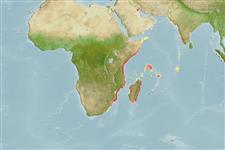Classification / Names
आम नाम | उपशब्द | Catalog of Fishes(वर्ग, प्रजाति) | ITIS | CoL | WoRMS | Cloffa
>
Eupercaria/misc (Various families in series Eupercaria) >
Labridae (Wrasses) > Corinae
Etymology: Pseudojuloides: Greek, pseudes = false + Greek, iouis = a fish without identification, perhaps some of genus Coris cited by Plinius + Greek, oides = similar to (Ref. 45335); polackorum: Named for Dennis and Sally Polack, whose underwater photographs first brought attention to this new species; noun in the genitive case (plural).
Environment: milieu / climate zone / गहराई सीमा / distribution range
पारिस्थितिकी
समुद्री प्रवाल-भित्ति संयुक्त; गहराई सीमा 5 - 20 m. Subtropical
Southwestern Indian Ocean: from continental African coast from at least Sodwana Bay in Kwa-Zulu-Natal, South Africa to the Kenyan coastline; photos taken from northern Madagascar.
आकार / वज़न / Age
परिपक्व अवधि: Lm ? range ? - ? cm
Max length : 12.3 cm TL पुल्लिंग / अलिंग; (Ref. 4392)
Depth range (5-20 m) given by B. Victor (pers. comm. 10/18).
Life cycle and mating behavior
परिपक्व अवधि | पुनरुत्पत्ति | मछलीऔ का अंडे देना | अंडे | Fecundity | लार्वा
Connell, A.D., B.C. Victor and J.E. Randall, 2015. A new species of Pseudojuloides (Perciformes: Labridae) from the south-western Indian Ocean. J. Ocean Sci. Found. 14:49-56. (Ref. 103846)
IUCN Red List Status (Ref. 130435: Version 2024-2)
Threat to humans
Harmless
Human uses
साधन
Special reports
Download XML
इंटरनेट स्रोत
Estimates based on models
Phylogenetic diversity index (संदर्भ
82804): PD
50 = 0.5000 [Uniqueness, from 0.5 = low to 2.0 = high].
Bayesian length-weight: a=0.00977 (0.00466 - 0.02049), b=3.07 (2.90 - 3.24), in cm total length, based on LWR estimates for this (Sub)family-body shape (Ref.
93245).
Trophic level (संदर्भ
69278): 3.4 ±0.4 se; based on size and trophs of closest relatives
लौटाव (संदर्भ
120179): ऊंचा, न्यूनतम जनसंख्या दुगनी समय अवलागत 15 महीने। (Preliminary K or Fecundity.).
Fishing Vulnerability (Ref.
59153): Low vulnerability (10 of 100).
🛈
